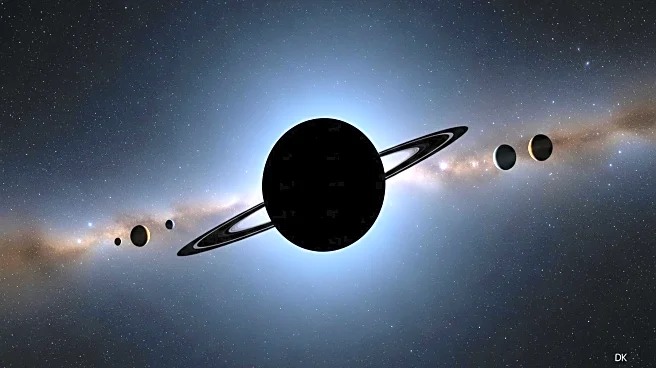What is the story about?
What's Happening?
In October, Saturn becomes a prominent feature in the night sky for observers in the Southern Hemisphere. Although it reached its peak visibility in late September, the planet remains a striking sight in the northeastern corner of Aquarius. Saturn's rings, which are nearly edge-on this month, allow for better visibility of its atmospheric details and moons, such as Titan, Tethys, Dione, and Rhea. Meanwhile, Mercury and Mars are visible in the western evening sky, with Mercury reaching its greatest elongation on October 29. Jupiter and Venus also make appearances, with Jupiter visible after midnight in Gemini and Venus shining brightly in the morning twilight. Additionally, a waxing crescent Moon will occult Antares in Scorpius on October 25, visible from southern South America.
Why It's Important?
The visibility of these celestial bodies offers a unique opportunity for amateur astronomers and sky enthusiasts to observe and study planetary movements and characteristics. Saturn's rings, although less visible this month, still provide a spectacle, while the proximity of Mercury and Mars offers a chance to observe planetary conjunctions. These events not only enhance public interest in astronomy but also provide educational opportunities for schools and science programs. The visibility of these planets can inspire interest in space exploration and science, potentially influencing future generations of astronomers and scientists.
What's Next?
As the month progresses, observers can look forward to the conjunction of Mercury and Mars on October 19, when the two planets will be just 2° apart. This event, along with Mercury's greatest elongation on October 29, will be key highlights for sky watchers. The occultation of Antares by the Moon on October 25 will also be a significant event for those in southern South America. These celestial events may prompt increased activity in observatories and among amateur astronomers, leading to public viewing events and educational outreach.
Beyond the Headlines
The October sky offers more than just planetary observations; it also provides a chance to explore constellations like Pisces, which is easily located below Saturn in Aquarius. The Circlet asterism within Pisces serves as a guide to the vernal equinox, an important astronomical marker. These observations can deepen understanding of celestial navigation and the historical significance of constellations in different cultures. The study of these patterns and their mythological origins can enrich cultural appreciation and scientific knowledge.
AI Generated Content
Do you find this article useful?














